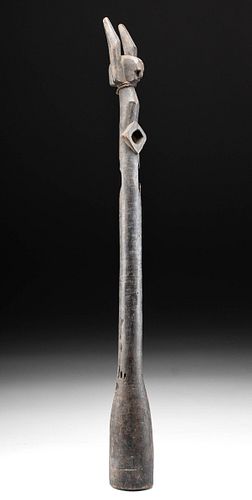20th C. African Dogon Wooden Oliphant
Lot 155b
About Seller
Artemis Fine Arts
686 S Taylor Ave, Ste 106
Louisville, CO 80027
United States
Selling antiquities, ancient and ethnographic art online since 1993, Artemis Gallery specializes in Classical Antiquities (Egyptian, Greek, Roman, Near Eastern), Asian, Pre-Columbian, African / Tribal / Oceanographic art. Our extensive inventory includes pottery, stone, metal, wood, glass and textil...Read more
Estimate:
$200 - $300
Absentee vs Live bid
Two ways to bid:
- Leave a max absentee bid and the platform will bid on your behalf up to your maximum bid during the live auction.
- Bid live during the auction and your bids will be submitted real-time to the auctioneer.
Bid Increments
| Price | Bid Increment |
|---|---|
| $0 | $25 |
| $300 | $50 |
| $1,000 | $100 |
| $2,000 | $250 |
| $5,000 | $500 |
| $10,000 | $1,000 |
| $20,000 | $2,500 |
| $50,000 | $5,000 |
| $100,000 | $10,000 |
| $200,000 | $20,000 |
About Auction
By Artemis Fine Arts
Jul 1, 2020
Set Reminder
2020-07-01 10:00:00
2020-07-01 10:00:00
America/New_York
Bidsquare
Bidsquare : Ancient | Near-Eastern | Asian Art
https://www.bidsquare.com/auctions/artemis-gallery/ancient-near-eastern-asian-art-5276
Ancient art from Egypt, Greece, Italy and the Near East, as well as Asian, Fossils, Pre-Columbian, Native American, African / Tribal / Oceanic, Spanish Colonial, Russian Icons, Fine art, much more! Artemis Fine Arts info@artemisfinearts.com
Ancient art from Egypt, Greece, Italy and the Near East, as well as Asian, Fossils, Pre-Columbian, Native American, African / Tribal / Oceanic, Spanish Colonial, Russian Icons, Fine art, much more! Artemis Fine Arts info@artemisfinearts.com
- Lot Description
West Africa, Mali, Dogon peoples, ca. early to mid-20th century CE. A hand-carved wooden wind instrument known as an oliphant, so-called because they were originally made from elephant ivory. The elongated tubular body is covered in dark brown pigment and features a broad tone hole on the bottom, a narrow neck, and a stylized anthropomorphic head finial adorned with a pair of projecting horns. The diamond-shaped mouthpiece is intended to have air blown across it similar to a flute, however this example does not produce any sound. Nice patina has formed across the surfaces. Size: 2.75" W x 30" H (7 cm x 76.2 cm)
Provenance: Estate of R. Pearson, Denver, Colorado, USA, acquired in December 2016; Mr. Pearson collected from the third quarter of the 20th century until he passed away; ex-Arte Primitivo Gallery, New York, New York, USA; ex-Christopher Mount collection, acquired as a gift from his father, Marshall Mount
All items legal to buy/sell under U.S. Statute covering cultural patrimony Code 2600, CHAPTER 14, and are guaranteed to be as described or your money back.
A Certificate of Authenticity will accompany all winning bids.
We ship worldwide and handle all shipping in-house for your convenience.
#156312Old repair to one horn on head with a pair of iron pins. Small areas of loss just beneath mouthpiece as shown. Minor nicks, abrasions, and encrustations to head, mouthpiece, body, and tone hole, with fading to original pigment. Nice earthen deposits throughout. Instrument does not make any sound when air is blown across the mouthpiece.Condition
- Shipping Info
-
All shipping is handled in-house for your convenience. Your invoice from Artemis Gallery will include shipping calculation instructions. If in doubt, please inquire BEFORE bidding for estimated shipping costs for individual items.
-
- Buyer's Premium



 EUR
EUR CAD
CAD AUD
AUD GBP
GBP MXN
MXN HKD
HKD CNY
CNY MYR
MYR SEK
SEK SGD
SGD CHF
CHF THB
THB















